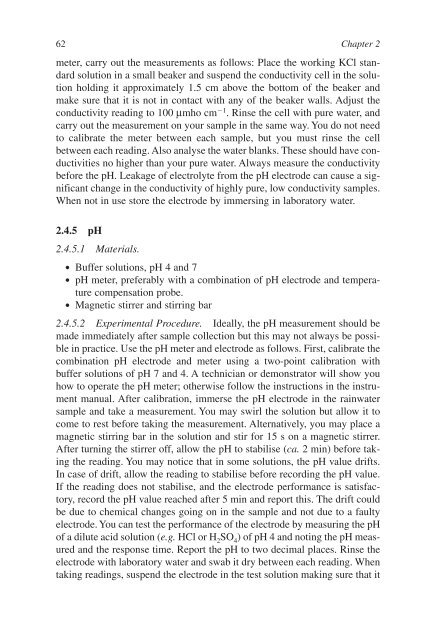Chapter 2 Rainwater Analysis (Phân tích nước mưa) - Practical Environmental Analysis, 2nd Edition - M. Radojevic, V. Bashkin
https://app.box.com/s/xse2wn3eson14p2iefjpryednq896xhy
https://app.box.com/s/xse2wn3eson14p2iefjpryednq896xhy
Create successful ePaper yourself
Turn your PDF publications into a flip-book with our unique Google optimized e-Paper software.
62 <strong>Chapter</strong> 2<br />
meter, carry out the measurements as follows: Place the working KCl standard<br />
solution in a small beaker and suspend the conductivity cell in the solution<br />
holding it approximately 1.5 cm above the bottom of the beaker and<br />
make sure that it is not in contact with any of the beaker walls. Adjust the<br />
conductivity reading to 100 µmho cm 1 . Rinse the cell with pure water, and<br />
carry out the measurement on your sample in the same way. You do not need<br />
to calibrate the meter between each sample, but you must rinse the cell<br />
between each reading. Also analyse the water blanks. These should have conductivities<br />
no higher than your pure water. Always measure the conductivity<br />
before the pH. Leakage of electrolyte from the pH electrode can cause a significant<br />
change in the conductivity of highly pure, low conductivity samples.<br />
When not in use store the electrode by immersing in laboratory water.<br />
2.4.5 pH<br />
2.4.5.1 Materials.<br />
● Buffer solutions, pH 4 and 7<br />
● pH meter, preferably with a combination of pH electrode and temperature<br />
compensation probe.<br />
● Magnetic stirrer and stirring bar<br />
2.4.5.2 Experimental Procedure. Ideally, the pH measurement should be<br />
made immediately after sample collection but this may not always be possible<br />
in practice. Use the pH meter and electrode as follows. First, calibrate the<br />
combination pH electrode and meter using a two-point calibration with<br />
buffer solutions of pH 7 and 4. A technician or demonstrator will show you<br />
how to operate the pH meter; otherwise follow the instructions in the instrument<br />
manual. After calibration, immerse the pH electrode in the rainwater<br />
sample and take a measurement. You may swirl the solution but allow it to<br />
come to rest before taking the measurement. Alternatively, you may place a<br />
magnetic stirring bar in the solution and stir for 15 s on a magnetic stirrer.<br />
After turning the stirrer off, allow the pH to stabilise (ca. 2 min) before taking<br />
the reading. You may notice that in some solutions, the pH value drifts.<br />
In case of drift, allow the reading to stabilise before recording the pH value.<br />
If the reading does not stabilise, and the electrode performance is satisfactory,<br />
record the pH value reached after 5 min and report this. The drift could<br />
be due to chemical changes going on in the sample and not due to a faulty<br />
electrode. You can test the performance of the electrode by measuring the pH<br />
of a dilute acid solution (e.g. HCl or H 2 SO 4 ) of pH 4 and noting the pH measured<br />
and the response time. Report the pH to two decimal places. Rinse the<br />
electrode with laboratory water and swab it dry between each reading. When<br />
taking readings, suspend the electrode in the test solution making sure that it


















